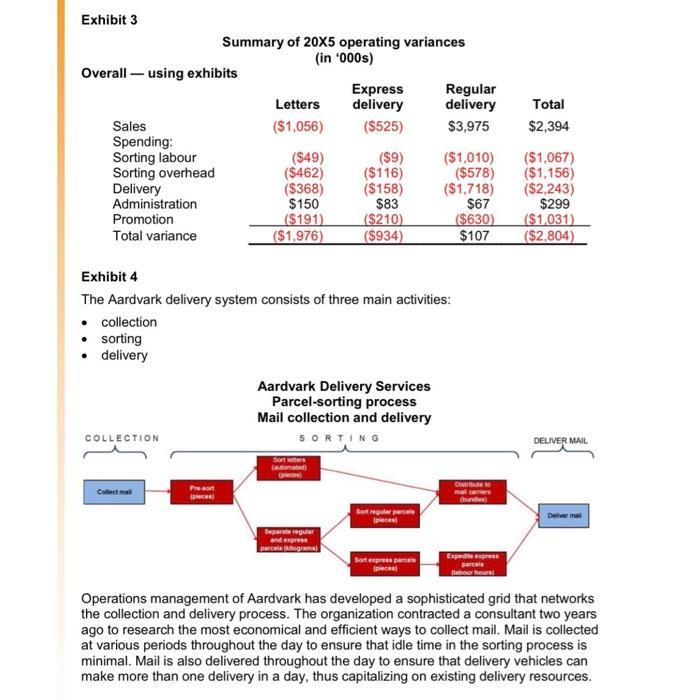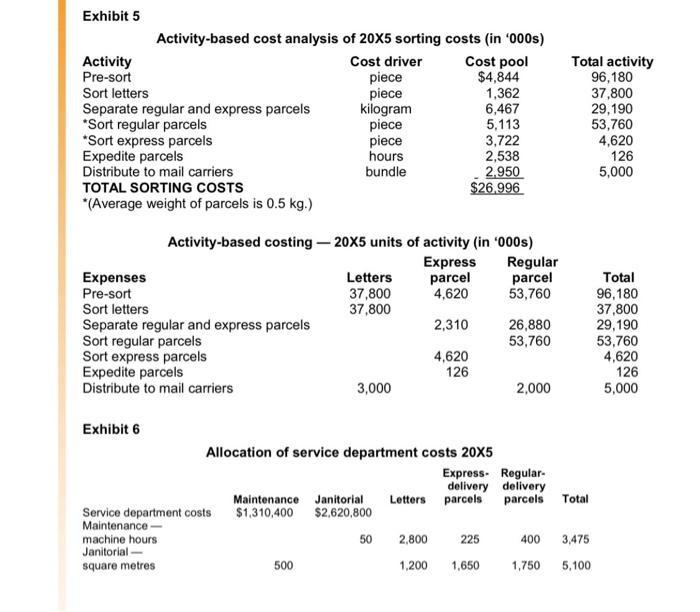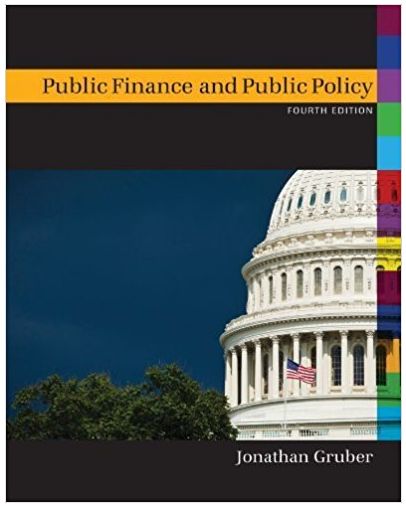Aardvark Delivery Service (ADS)' was formed 30 years ago with a mandate to establish a private delivery system in the country of Aardvark. By 20X5,
Aardvark Delivery Service (ADS)' was formed 30 years ago with a mandate to establish a private delivery system in the country of Aardvark. By 20X5, ADS was handling close to 30 million pieces of mail and 29 million kilograms of parcels per year. Arthur Chapman has spent several years working with small-scale private delivery companies in many countries. Recently, Arthur was hired by ADS to assist in improving its operating and financial performance. The owners of ADS were dissatisfied with the recent trend in financial results (Exhibits 1 to 3). Farid Banai, president of ADS, has called a meeting with Arthur and Truc Nguyen, operations manager, to review the 20X5 results.
PRESIDENT (Farid Banai): From where I sit, the situation doesn't look very good. Our volume is fairly constant; however, the deficit keeps getting larger. We planned to break even in 20X5 but failed to accomplish our goal. The basic mission of ADS is to provide effective and efficient delivery services to the entire population and to network with other delivery services around the world. The vast distances, rugged terrain, natural obstacles and severe winter weather all contribute to making our job a great challenge. We calculate, for example, that in the month of March it costs us $2.75 to send a letter from a small town in our most easterly region to one of the northern outposts, but our,revenue on that letter is still just $0.48.
ARTHUR: Tell me about the profitability of each type of delivery service ADS offers.
PRESIDENT: Letter delivery has not been profitable even after the installation of more highly automated equipment. We had planned on express parcels generating the most profit for us; however, the 20X5 results were disappointing. Some of the issues are that other private carriers are encroaching on the parcel end of our business and the number of kilograms in sales for express-delivery parcels were less than budget.
ARTHUR: Are there any issues with cost?
OPERATIONS MANAGER (Truc Nguyen): Costs keep rising. The basic costs at ADS are sorting, delivery, administration and promotion. Here's a copy of the budget for 20X5
(Exhibit 1). All of the costs have been classified as fixed except for sorting labour, which is strictly variable.
You'll notice that we split the sorting costs into labour and overhead and separately keep track of both classes of parcels, express delivery and regular delivery. Both the standard and actual sorting labour rates were raised to $20.00 per hour in 20X5. We don't plan on increases for 20X6 as our rates are on par with both private and government-funded delivery services.
I sense that we may not be accurately allocating sorting costs to each of our delivery services. When we implemented the automated sorting equipment for processing letters two years ago, our margins changed very little. I assumed that variable sorting labour
costs would decrease for letters. Administration costs are categorized as 20% maintenance costs and 40% janitorial costs, with the remainder classified as office administration, which includes office supplies, phone charges and consulting fees. The maintenance and janitorial costs have remained stable over the past couple of years; however, the office administration costs seem to fluctuate somewhat, depending on volume.
We split the administration costs as roughly 50% of the total to letters and prorate the remainder to the parcel services based on total weight for each department. It's a fairly large portion of our costs that we arbitrarily allocate to each service.
The allocation of delivery costs to each of our services has been affirmed by our controller, who has worked with me and an outside consultant to set effective rates and cost measures. We've already confirmed that the 20X5 variance in delivery costs is due to the increase in fuel prices across the country.
We intend to maintain advertising costs for 20X6 and are confident that it will boost sales volume. We predict that letter sales will increase to 42 million pieces, while express-delivery parcel sales will increase to 2.5 million kilograms and regular-delivery
parcel sales will increase to 28 million kilograms. ADS's overall mandate is for operations to at least break even.
ARTHUR: Has anyone performed an analysis of the sorting and administrative costs to determine whether these costs have been properly allocated to the services that incur them?
OPERATIONS MANAGER: We haven't had the time to properly assess cost allocation. We contracted a consultant last year to review the costing of our services. She advised that we allocate costs using an activity-based approach; however, the contract ended before we were able to implement the plan. I've included an illustration of the sorting process (Exhibit 4) and a copy of the suggested sorting activities and cost pools (Exhibit
5). She also did an analysis of the administration costs, first, to determine a better way to allocate service department costs (Exhibit 6) and, second, to understand the behaviour of the office administration costs (Exhibit 7).
ARTHUR: And what about revenues?
OPERATIONS MANAGER: Well, the rates throughout 20X5 were $0.48 for the average letter, $2.10 per kilogram on express-delivery parcels and $1.05 per kilogram for regular-delivery parcels. So far, we've only been able to justify increasing the letter rate to $0.49 in 20X6.
PRESIDENT: Things didn't go too well for ADS in 20X5 (see Exhibit 2) and unless some changes are made, I don't see much future improvement. The profits for the standard letter service appear to be pretty bleak, but our owners refused our request to drop the letter delivery business.
ARTHUR: So the future is in parcels?
PRESIDENT: When I saw the 20X5 results, that seemed to be the way we were heading. However, I'm skeptical of this approach until we have a better handle on costing. That's what I'm hoping you'll do for us. As I see it, there are two tasks I would like you to accomplish:
1. Provide a better allocation of sorting and administrative costs between departments.
2. Take a closer look at the express-delivery parcel opportunities. Many of our customers who use our letter and regular-delivery service also use the express-delivery parcel service. I believe there's a future in this line of business, but for now we need to increase our bottom line. In support of that, I would like you to investigate the following two options relating to express-delivery parcels:
Increase the rate to $2.75 per kilogram. According to marketing, we might lose 2% of our business if we do this. However, due to increases in fuel costs and demand, many of our competitors are increasing prices as well, so we don't expect this decrease in demand to continue.
Increase our advertising campaign for express-delivery parcels by $500,000. We expect this will increase our sales by 15%.
Well, I guess that's all for today. We have lots of things to attend to. I hope that you will be able to give us some advice on what we should be doing.
ARTHUR: Thank you for your guidance and assistance. I'll begin my analysis immediately and report back as soon as possible.
Required:
For the first requirement, assume the role of a junior management accountant internal to ADS. For the balance, assume the role of Arthur Chapman and prepare a report to Farid Banai, President of ADS. The report should analyze ADS's current cost allocations and provide advice for the future. It should include the following:
Overview: Discuss the 20X5 operating variances (Exhibit 3). The variances in
Exhibit 3 are based on the budgeted and actual figures in Exhibits 1 and 2
(8 marks: 2 for each operating line and 2 for a summary)
2. Analysis: Using the documents provided by the consultant, prepare an analysis of
each of the following 20X5 costs: (28 marks)
a) Sorting labour and overhead: Reallocate the total sorting labour and sorting
overhead costs to each of the departments using the activity-based costing
analysis in Exhibit 5. (10 marks)
b) Administration costs:
Service department portion of administration costs: Prepare a comparison of
cost allocations of the janitorial and maintenance departments to the
production departments using the direct and step methods. Use the allocation
bases provided in Exhibit 6 and begin with the janitorial costs using the step
method. Your analysis should discuss which method provides the most
reasonable estimate of service department costs to production departments
and explain why it is the best method. (8 marks)
Office administration costs: Review the summary printout of two Excel
regression analyses (Exhibit 7): one that tests the correlation between
administration employee hours and office administration costs and one that
tests the correlation between documents used and office administration costs
Explain which activity driver is the best representation of cost behaviour and
reallocate the office administration costs to the production departments using
the 20X5 activities provided in the exhibit. As a result, the office
administration costs should be split into variable and fixed portions. Fixed
costs should be allocated among the services using the original allocation
base. (10 marks)
3.
Prepare a revised operating statement for 20X5 using the costing analyses from
requirement 2. Provide a short analysis of the results including possible
explanations. (10 marks)
4.
Prepare a 20X6 budgeted operating statement using the cost allocations developed
in requirement 2 and the expected costs provided in the case. Assume the following:
a) The average size of parcels will continue to be 0.5 kg.
b) Activity-based unit costs will remain the same for 20X6.
c) The number of bundles for activity-based costing will remain the same
d) For expedited parcels, the hours used varies by the number of parcels.
) Service department allocations and fixed costs will be unchanged.
(10 marks)
5. Analyze the president's two options concerning the express-delivery parcel
business. Your analysis should use the 20X6 budgeted figures and the additional
information provided in Exhibit 8. Based on the quantitative analysis, make a
recommendation and provide your reasons. Your recommendation should include at
least two changes that the organization could make regarding the express-delivery
parcel business. (9 marks)
6. Provide management with at least two observations you have made during your
research that can be considered for future analysis. (2 marks)
Note: In addition to the above, 3 marks are awarded for format and professionalism.



Pre-sort
After being collected, all mail enters the pre-sort process, where it is separated into
letters and parcels.
Sort letters
Letters are sorted using automated sorting equipment. The capacity of the equipment is
10,000 letters per hour. Letters are sorted by delivery route. A delivery route can consist
of a street, a subdivision or a building.
Separate regular-delivery and express-delivery parcels
After the pre-sort, all parcels are sorted into regular-delivery and express-delivery
groups. Because of the distance from the pre-sort area to the parcel-sorting area, this
step takes longer if there are heavier parcels, as they are moved manually.
Sort regular-delivery parcels
Regular-delivery parcels are manually sorted and combined with letters to be delivered
by the appropriate carrier.
Sort express-delivery parcels
Express-delivery parcels are sorted using a grid that is based on the availability of more
costly but quicker delivery methods such as air and commercial carriers.
Distribute to mail carriers
Letters and regular-delivery parcels are sorted by route and put into bundles. There is
one bundle per delivery route, regardless of the number of items. These bundles are
distributed to mail carriers, who sort the mail for their routes into the most effective order
for delivering the mail.
Expedite express-delivery parcels
A team of four experts works around the clock to determine the most efficient way to
send express-delivery parcels to ensure 24- to 48-hour delivery. The expediting process
is labour intensive, and different hours are required for each mode of transportation.



Exhibit 1 Aardvark Delivery Services 20X5 budget (all figures in '000s) Express posts Letters parcels 40,000 2,560 $0.48 $2.10 $19.200 $5,376 2,051 788 6,310 1,578 7,140 840 3,426 342 964 368 19,891 3,915 $1,461 Volume (pieces) Volume (kilograms) Rates Total revenue Expenses: Sorting labour Sorting overhead Delivery Administration' Promotion Total expenses Surplus (deficit) ($691) Regular post parcels Total 23.094 $1.05 $24,249 $48,825 6,158 8,997 7,888 15,775 7,522 15,502 3,084 6,851 368 1,699 25,019 48,825 ($0) ($771)
Step by Step Solution
3.50 Rating (153 Votes )
There are 3 Steps involved in it
Step: 1
Overview The 20X5 operating variances presented in Exhibit 3 show that while the overall revenue of Aardvark Delivery Service ADS was in line with the budgeted figure the expenses exceeded the budgete...
See step-by-step solutions with expert insights and AI powered tools for academic success
Step: 2

Step: 3

Ace Your Homework with AI
Get the answers you need in no time with our AI-driven, step-by-step assistance
Get Started


